Ironing the wash/laundry before electric irons and steam irons
Ironing in the past was a much more major job than it is today. There was a lot of it because there were no crease-resistant fabrics; every item had to be made just the right dampness because there were no steam irons; and as there was no electricity to heat the irons or control their temperature, this had to be done manually from a coal fire. This page describes the irons and explains and illustrates the process of ironing at the time.
____
Extracted from the memoirs of the webmaster's mother (1906-2002) and edited by the webmaster with further research
Ironing day: Tuesday
Ironing Monday's laundry, was always a task for Tuesday when I was growing up in the early 1900s. So it was in my grandmother's Victorian times and so it continued in some households at least into the 1950s.
There were two main reasons.
- Ironing was such time-consuming work that there was no time for cooking, and the left-overs from the Sunday roast could still make a good meal on Tuesday.
- If managed carefully, there was still a suitable amount of dampness left in from the Monday wash to make ironing easier.
The right dampness for ironing
It was quite a skill to get the washing to the right dampness for ironing, because if it was too dry, the creases wouldn't iron out. Yet if it was too wet, the washing creased again immediately afterwards.
The washing had always been carefully folded and rolled up on Mondays so that the dampness would spread evenly through it by the next day. If, when it came to do the ironing, my mother thought the washing too dry, she would 'damp it down' by sprinkling it all with water. This, though, was less effective than Monday's damping down because the dampness did not spread evenly through the washing.
The irons
The irons, sometimes called 'smoothing irons' were made of cast iron. There were two sorts. Both needed to be heated, but the heating was done differently.
Flat irons
The 'flat iron', as its name implies, was not deep They came in pairs - see the first of the following pictures - so that one could be in use while the other was heating up.
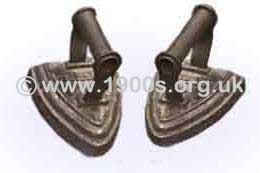
Flat irons
Flat irons had to be heated on the cooking range or kitchen fire by placing their flat faces close up against the bars, as shown in the picture.
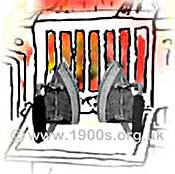
Two flat irons heating up with their faces close against the hot coals of the kitchen range fire. Once ironing began, one iron would be in use while the other was heating.
Box irons
The 'box iron' was hollow - see the following picture. Inside was a specially shaped piece of clay, which was known as a 'slug' which supplied the heat. There was always a pair of slugs to every iron, so that one could be in use while the other was heated up.
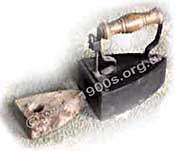
A box iron with one of its slugs
Slugs were heated by putting them right into the fire. Once a slug was hot, it was removed with a specially shaped long hook and placed inside the iron.
Testing the temperature of the irons
There were of course no thermostats for these irons. My mother would test the temperature, either by putting it close to her cheek or by licking her finger and touching the hot surface to see how quickly it went "psh" as the wet from her finger evaporated.
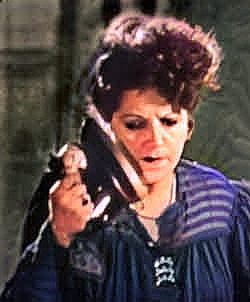
Woman testing the temperature of an iron by holding it up to her cheek. Edited and coloured detail of a screen shot from an old film
Fortunately as the items for ironing were all natural fibres, they did not sizzle and melt at relatively low heat temperatures, but they could still scorch if the irons were too hot.
The ironing board: the kitchen table
My mother, like all the other women I knew, always did her ironing on the table in the kitchen. The full width of the table was particularly useful for ironing sheets and table cloths.
My mother protected the table with an old blanket folded into several layers with an old sheet on top, kept specially for ironing.
Stands for hot irons
As the whole of the iron got heated, not just the bottom surface, it had to be placed where it couldn't cause burning while the clothes etc were being positioned. My mother always used a bar of household soap which she placed the iron on. The soap apparently made the iron glide more easily while also keeping the intense heat of the iron off the old sheet.
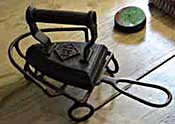
Stand for a flat iron, photographed in Tredegar House.
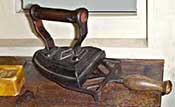
A different design of stand for a box iron, photographed in Milestones Museum.
There were of course shop-bought iron stands, as shown in photos, but a bar of Sunlight soap served the purpose well.
Keeping handles cool
As the irons got really hot, the iron handle, being cast iron, did too. So a cloth had to be wrapped round the handles while the irons were used.
Wooden handles did not get hot so quickly, but a cloth was still useful to wipe away any soot that found its way onto the iron from the burning coals.
Airing after ironing
In the summer, after the washing had been ironed, it would be put out into the garden again to air, and the smell that came from it was wonderful. It was really lovely to get into bed between clean sheets that had been washed at home and dried outside in the sun and wind.
In the cold and damp of winter, the ironing would be aired indoors, in the same way as the washing was dried in bad weather.
The main meal on Tuesday ironing day
Ironing was hot work, because the kitchen range had to be kept hot enough to heat the irons. It was also steamy work which made it all the more exhausting, and there was a lot of it because there were no crease-resistant fabrics.
So although Tuesday's ironing was probably not as tiring as Monday's washdays, my mother still couldn't manage to do cooking. So Tuesday dinner [lunch] saw the last of the Sunday roast in the form of sliced cold meat, with mustard pickle and bubble and squeak made from Sunday's vegetables.
| sources | webmaster | contact |
Text and images are copyright
If you can add anything to this page or provide a photo, please contact me.



